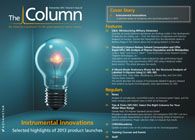Mummified Snacks
The ancient Egyptians embalmed meat mummies as an afterlife snack in the same way as their dead, according to the findings of a gas chromatography–mass spectrometry (GC–MS) analysis.
The ancient Egyptians embalmed meat mummies as an afterlife snack in the same way as their dead, according to the findings of a gas chromatography–mass spectrometry (GC–MS) analysis. The team from the University of Bristol (Bristol, UK) and the American University in Cairo (Cairo, Egypt) collaborated to analyze the chemical compositions of samples and tissues from meat mummies excavated by the Cairo Museum and the British Museum. Of particular interest, the team found evidence of the use of Pistacia resin on a beef rib mummy, a substance rarely even seen in the embalming of humans. - K.A. Clark, S. Ikram, and R.P. Evershed, PNAS Early Edition, DOI: 10.1073/pnas.1315160110 (2013).
This story originally appeared in The Column. Click here to view that issue.

Regulatory Deadlines and Supply Chain Challenges Take Center Stage in Nitrosamine Discussion
April 10th 2025During an LCGC International peer exchange, Aloka Srinivasan, Mayank Bhanti, and Amber Burch discussed the regulatory deadlines and supply chain challenges that come with nitrosamine analysis.










